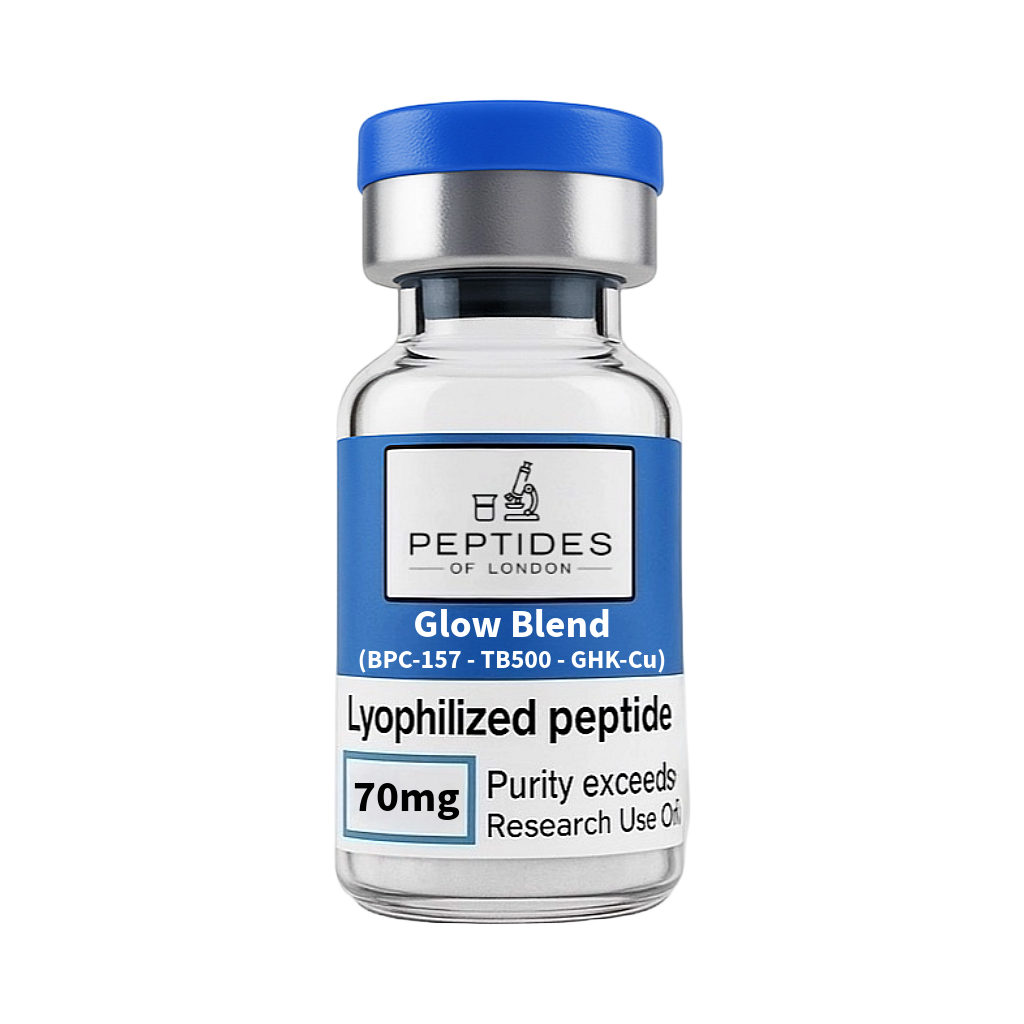Peptides of London
Glow Blend 70mg - (BPC-157 10mg | TB500 10mg | GHK-Cu 50mg)
Glow Blend 70mg - (BPC-157 10mg | TB500 10mg | GHK-Cu 50mg)
Couldn't load pickup availability
GLOW Peptide Blend —
70 mg Research Vial
Composition: GHK-Cu 50 mg • BPC-157 10 mg • TB-500 (Thymosin-β4 fragment) 10 mg
Format: Lyophilised powder • RUO (Research Use Only)
Also known as / identifiers
-
GHK-Cu (glycyl-L-histidyl-L-lysine•copper, “copper peptide”)
Sequence: H-Gly-His-Lys-OH • CAS: 89030-95-5 -
BPC-157 (Body Protection Compound-157; PL 14736)
Sequence: H-Gly-Glu-Pro-Pro-Pro-Gly-Lys-Pro-Ala-Asp-Asp-Ala-Gly-Leu-Val-OH • CAS: 137525-51-0 -
TB-500 (Thymosin Beta-4 fragment; ACTN-sequestering peptide)
Fragment of Tβ4; commonly supplied as TB-500 for research • CAS (Tβ4): 77591-33-4
UK research supplier. Each batch is HPLC-profiled with mass-spectrometry identity confirmation. No excipients, fillers or mannitol added.
Why a blend?
GLOW combines three well-characterised research peptides that act on complementary repair pathways. In pre-clinical models:
-
Angiogenesis & perfusion:
BPC-157 and TB-500 have been reported to up-regulate VEGF/VEGFR signalling and eNOS activity, supporting neovascularisation; GHK-Cu promotes endothelial proliferation and capillary formation via copper-dependent signalling. -
Cell migration & matrix remodelling:
TB-500 modulates actin dynamics and cell motility; BPC-157 enhances fibroblast/tenocyte migration; GHK-Cu up-regulates genes linked with collagen I/III, elastin and integrins. -
Inflammatory balance & oxidative stress:
All three peptides have shown anti-inflammatory and antioxidant effects in animal/cell studies, including modulation of NF-κB-related cytokines and MMP/TGF-β pathways.
Intended research domains (examples): connective-tissue biology, dermal remodeling, tendon/ligament models, angiogenesis assays, wound-healing models, extracellular-matrix (ECM) gene expression, hair-follicle biology.
Component spotlights (research summary)
GHK-Cu (50 mg)
- Endogenous tripeptide–copper complex reported to stimulate collagen, elastin, and glycosaminoglycan synthesis, enhance keratinocyte and fibroblast activity, and promote angiogenesis in skin/tissue models.
- Transcriptomic work has shown broad gene-expression shifts toward tissue remodeling and antioxidant defense (e.g., up-regulation of integrins, down-regulation of proteolysis-related genes).
BPC-157 (10 mg)
- Gastric-derived pentadecapeptide studied in rodent models for angiogenesis (VEGFR2/FAK-paxillin), nitric-oxide signalling, and cytoprotection.
- Pre-clinical data describe accelerated tendon, ligament, and intestinal healing, and support for micro-vascular integrity in various injury models.
TB-500 / Tβ4 fragment (10 mg)
- Thymosin-β4 is an actin-sequestering peptide; TB-500 research commonly targets cell migration, endothelial tube formation, and progenitor-cell mobilisation.
- Animal and cell studies report reduced inflammation, enhanced re-epithelialisation, and VEGF-linked angiogenesis.
Specifications
- Total fill: 70 mg lyophilised blend (GHK-Cu 50 mg, BPC-157 10 mg, TB-500 10 mg)
- Appearance: white to off-white lyophilised cake
- Purity: ≥ 99% (HPLC profile) • Identity: MS-confirmed
- Additives: none (no mannitol or carriers)
Recommended reconstitution (lab guidance)
- Solvent: sterile bacteriostatic water (0.9% benzyl alcohol) or suitable aqueous buffer for in-vitro work.
- Gently add solvent down the vial wall; avoid vigorous shaking.
- Storage (unopened): −20 °C. After reconstitution: aliquot, store 2–8 °C for short-term or −20 °C for extended research use. Avoid repeated freeze–thaw.
UK peptide supplier • research peptides UK • GHK-Cu, BPC-157, TB-500 blend • HPLC tested peptides • mass-spectrometry verified • lyophilised peptide vials • angiogenesis research peptide • ECM/collagen research • tendon/ligament model peptide • UK stock • fast UK shipping • RUO only
Notes for researchers
- The three components may exhibit synergy in angiogenesis, ECM deposition and inflammatory modulation; verify assay-specific compatibility and stability in your system before combining with other agents.
- Results reported to date are pre-clinical (in vitro/animal). Parameters and outcomes can vary by model, dose, and matrix.
- Pickart L. et al. Work on GHK-Cu in dermal remodeling, collagen synthesis, and gene-expression modulation.
- Frank S. et al.; Malinda K. et al. Thymosin-β4/TB-500 promoting angiogenesis and wound repair via actin dynamics and VEGF/eNOS pathways.
- Sikiric P. et al.; Chang C.H. et al. BPC-157 studies on angiogenesis, cytoprotection, and tendon/ligament healing in rodent models.
Strictly for Research use only. Not for human consumption.
Share


